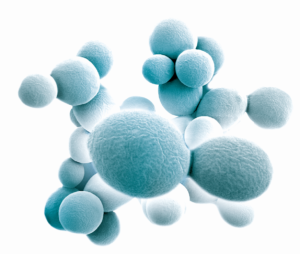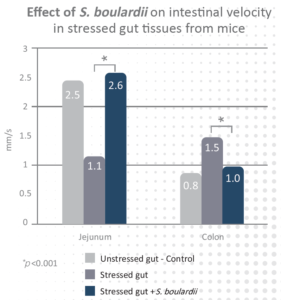
S. boulardii features
Documented probiotic yeast for gut health benefits

S. boulardii has been discovered in 1923 by Henri Boulard during a cholera epidemic in Vietnam on tropical fruits skin and was first marketed in 1953 as a drug to prevent acute diarrhea.
Since then, the yeast S. boulardii has been documented in several acute and chronic gut disorders: preventive treatment of antibiotic-associated diarrhea, Helicobacter pylori and Clostridium difficile infections or traveler’s diarrhea [Hojsak, 2018]. It has shown to reduce the duration of occasional diarrhea by approximately one day.
- Analysed in over 100 clinical studies.
- Proven reliable and harmless for children and adults.
- Recommended by the European Society for Paediatric Gastroenterology Hepathology and Nutrition (ESPGHAN).
Mechanisms of action
![]()
Luminal effect
- Provides antimicrobial action by binding to opportunistic bacteria.
- Produces a neutralizing effect by secreting proteins that inactivate metabolites of opportunistic bacteria.
![]()
Trophic action
- Ensures barrier integrity by strengthening the tight junctions of epithelial cells.
- Improves intestinal mucosa metabolism: SCFAs production, enzymes enhancement, antioxidant activity.
![]()
Immunity modulation
- Stimulates the immune system, both innate and adaptative immunity.
- Modulates the imminue signalling pathways.
 Scientific evidences
Scientific evidences
1. In vitro mechanistic evidence on S. boulardii CNCM I-1079
![]() [Gaisawat, 2019] – Antioxidant activity and intestinal metabolic homeostasis restoration in C. difficile model
[Gaisawat, 2019] – Antioxidant activity and intestinal metabolic homeostasis restoration in C. difficile model
- S. boulardii restored altered redox status associated with C. difficile infection by significantly increasing copper chelation (p<0.05) thereby reducing metal’s bioavailability used to catalyze free radical polymerization.
- S. boulardii significantly increased total SCFAs production (e.g. acetate, butyrate)
- S. boulardii restored H2S level
![]() [Audy, 2012] – Pro-inflammatory response down-regulation
[Audy, 2012] – Pro-inflammatory response down-regulation
- S. boulardii reduced gene expression involved in pro-inflammatory cytokine production.
2. In vivo scientific evidence on S. boulardii CNCM I-1079
![]() [West, 2016] – Acute stress-related intestinal dysmotility model
[West, 2016] – Acute stress-related intestinal dysmotility model
- S. boulardii reversed the effects of stress on small and large intestines, returning them to unstressed levels: velocity restoration (p<0.001) and frequency regulation (p<0.005).

DID YOU KNOW?
- 51% of consumers turn to probiotic products for digestive health purpose (1).
- 75% of probiotic supplements are sold worldwide to support digestive discomfort – 5% of these contain the probiotic yeast S. boulardii (2).
References: (1) – FMCG GURU https://fmcggurus.com/api/download-report-file.php?r=12921&f=12922 (2) – Lumina Product 2020
